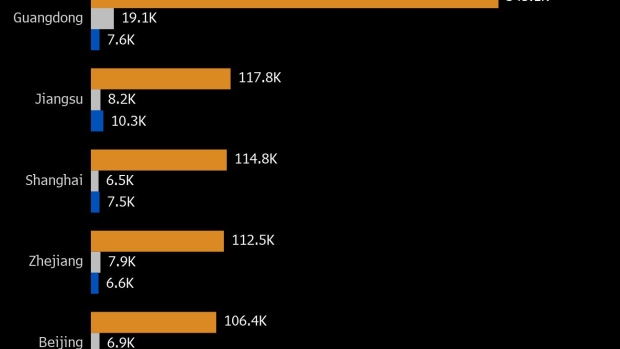Oct 21, 2022
This Chinese Province Has More EV Chargers Than All of the US
, Bloomberg News

(Bloomberg) -- Range anxiety is a thing of the past for electric vehicle owners in the Chinese province of Guangdong.
The coastal region, which borders Hong Kong, has built hundreds of thousands of public charging points — the EV equivalent of gas pumps — over the past few years. With 345,126 public chargers and 19,116 charging stations as of the end of September, Guangdong has the largest EV charging network in China, one that has more than doubled from a year ago, according to the China Electric Vehicle Charging Infrastructure Promotion Alliance. That’s around three times as many public chargers in the whole of the US, according to BloombergNEF data.
In a push to electrify their nations’ car fleets, governments around the world are trying to roll out and scale their public charging infrastructure swiftly enough to service new battery-powered cars. President Joe Biden’s infrastructure law devotes $5 billion to building a nationwide network of EV charging ports along major travel corridors in the US, while Germany has spent or pledged $6.4 billion to support the charging industry. But both the US and Europe have fallen well behind China in building out their networks. A BloombergNEF analysis counted 112,900 public chargers deployed across the US and 442,000 in Europe by the end of 2021, compared with 1.15 million in China.
That gap is only growing. In just the past 12 months, China added 592,000 public chargers — more than the total number the Biden administration wants by 2030. The government plans to build enough charging stations for 20 million electric vehicles by 2025, according to a January document by the National Development and Reform Commission and nine other ministries.
These charging pylons are installed by third-party utility operators, state-owned electric companies — the two biggest of which are State Grid Corp. of China and China Southern Power Grid — as well as EV automakers like Tesla Inc. and China’s Nio Inc. and Xpeng Inc. Tesla operates more than 8,700 Supercharger stalls across 370 cities in China — roughly a quarter of its global Supercharger network.
China’s efforts to forge a green infrastructure are paying off: domestic demand for cleaner cars now dramatically dwarfs that of Europe and the US. A quarter of all new cars purchased in China are new-energy vehicles, and NEV sales are forecast to hit a record 6 million this year.
In Guangdong, ubiquitous charging is also boosting electric car ownership. EV sales jumped 151% in the first half of the year, according to the Guangdong Bureau of Statistics. The province now has over 1.4 million electric vehicles, the highest share in the country, according to the National Monitoring and Management platform for New-Energy Vehicles.
“With more chargers, there’s less range anxiety. EV sales therefore go up,” said David Zhang, an automotive analyst who is also dean of the Jiangxi New Energy Technology Institute. “Having so many chargers is definitely a breakthrough, but we’ve got to remember that charging still takes a lot longer than refilling the gas tank. That’s now the real obstacle.”
Guangdong’s provincial government is also doubling down on EV manufacturing. One-in-eight electric cars sold in China is now made in Guangdong. From January to July, local EV production jumped more than two-fold from a year before. Strong production capabilities can have a spillover effect, improving customer experience and aftersales service and even lowering pricing within the province, said Zhang.
Yoyo Gu, a 40-year-old housewife from Guangdong, traded in her Dongfeng Citroen C4 internal-combustion sedan for a GAC AION V Plus electric SUV earlier this year as part of a provincial subsidy program to bolster EV adoption.
“I got around 8,000 yuan off the bill,” said Gu. That’s on top of the EV purchase-tax exemption, which the government has extended until the end of 2023.
For the first few months, she recharged her SUV overnight at public charging stations in her neighborhood, before finally installing a private charging outlet in the parking lot of her residential complex.
“When my friends talk about buying an electric car, no one worries about charging anymore,” said Gu. “The car park below our apartment added five new chargers in the past couple of months and we can easily find one on the road.”
©2022 Bloomberg L.P.





